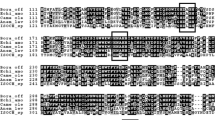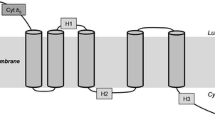Abstract
Fatty acid desaturase enzymes are capable of inserting double bonds between carbon atoms of saturated fatty acyl-chains to produce unsaturated fatty acids. A gene coding for a putative Δ9-fatty acid desaturase-like protein was isolated from a cold-tolerant Pseudomonas sp. A8, cloned and heterologously expressed in Escherichia coli. The gene named as PA8FAD9 has an open reading frame of 1185 bp and codes for 394 amino acids with a predicted molecular weight of 45 kDa. The enzyme showed high Δ9-fatty acid desaturase-like protein activity and increased overall levels of cellular unsaturated fatty acids in the recombinant E. coli cells upon expression at different temperatures. The results showed that the ratio of palmitoleic to palmitic acid in the recombinant E. coli cells increased by more than twice the amount observed in the control cells at 20 °C using 0.4 mM IPTG. GCMS analysis confirmed the ability of this enzyme to convert exogenous stearic acid to oleic acid incorporated into the recombinant E. coli membrane phospholipids. It may be concluded that the PA8FAD9 gene from Pseudomonas sp. A8 codes for a putative Δ9-fatty acid desaturase protein actively expressed in E. coli under the influence of temperature and an inducer.










Similar content being viewed by others
References
Mansilla, M., Banchio, C., & Mendoza, D. (2008). Signalling pathways controlling fatty acid desaturation. In P. Quinn & X. Wang (Eds.), Lipids in health and disease (Vol. 49, pp. 71–99). Netherlands: Springer.
Mansilla, M. C., & de Mendoza, D. (2005). The Bacillus subtilis desaturase: a model to understand phospholipid modification and temperature sensing. Archives of Microbiology, 183(4), 229–235.
Wan, X., Liang, Z., Gong, Y., Zhang, Y., & Jiang, M. (2013). Characterization of three Δ9-fatty acid desaturases with distinct substrate specificity from an oleaginous fungus Cunninghamella echinulata. Molecular Biology Reports, 40(7), 4483–4489.
Li, Y., Xu, X., Dietrich, M., Urlacher, V. B., Schmid, R. D., Ouyang, P., et al. (2009). Identification and functional expression of a Δ9-fatty acid desaturase from the marine bacterium Pseudoalteromonas sp. MLY15. Journal of Molecular Catalysis B, 56(2), 96–101.
Murata, N., & Wada, H. (1995). Acyl-lipid desaturases and their importance in the tolerance and acclimatisation to the cold of cyanobacteria. Biochemical Journal, 308(Pt 1), 1.
Shanklin, J., & Cahoon, E. B. (1998). Desaturation and related modifications of fatty acids 1. Annual Review of Plant Biology, 49(1), 611–641.
Altabe, S. G., Aguilar, P., Caballero, G. M., & de Mendoza, D. (2003). The Bacillus subtilis acyl lipid desaturase is a Δ5 desaturase. Journal of Bacteriology, 185(10), 3228–3231.
Mansilla, M. C., Cybulski, L. E., Albanesi, D., & de Mendoza, D. (2004). Control of membrane lipid fluidity by molecular thermosensors. Journal of Bacteriology, 186(20), 6681–6688.
Hashimoto, K., Yoshizawa, A. C., Saito, K., Yamada, T., & Kanehisa, M. (2006). The repertoire of desaturases for unsaturated fatty acid synthesis in 397 genomes. Genome Informatics, 17(1), 173–183.
Zhu, K., Choi, K. H., Schweizer, H. P., Rock, C. O., & Zhang, Y. M. (2006). Two aerobic pathways for the formation of unsaturated fatty acids in Pseudomonas aeruginosa. Molecular Microbiology, 60(2), 260–273.
Flowers, M. T., & Ntambi, J. M. (2008). Role of stearoyl-coenzyme a desaturase in regulating lipid metabolism. Current Opinion in Lipidology, 19(3), 248.
Li, Y., Dietrich, M., Schmid, R. D., He, B., Ouyang, P., & Urlacher, V. B. (2008). Identification and functional expression of a Δ9-fatty acid desaturase from Psychrobacter urativorans in Escherichia coli. Lipids, 43(3), 207–213.
Thompson, Julie, D., Higgins, D. G., & Gibson, T. J. (1994). Clustal W: Improving the sensitivity of progressive multiple sequence alignment through sequence weighting, position-specific gap penalties, and weight matrix choice. Nucleic Acids Research, 22(22), 4673–4680.
Kyte, J., & Doolittle, R. F. (1982). A simple method for displaying the hydropathic character of a protein. Journal of Molecular Biology, 157(1), 105–132.
Bendtsen, J. D., Nielsen, H., von Heijne, G., & Brunak, S. (2004). Improved prediction of signal peptides: SignalP 3.0. Journal of Molecular Biology, 340(4), 783–795.
Schägger, H., & Von Jagow, G. (1987). Tricine-sodium dodecyl sulfate-polyacrylamide gel electrophoresis for the separation of proteins in the range from 1 to 100 kDa. Analytical Biochemistry, 166(2), 368–379.
Garba, L., Wahhida, L., Ali, M. S. M., Oslan, S. N., & Rahman, R. N. Z. R. A. (2016). Unsaturated fatty acids in Antarctic Bacteria. Research Journal of Microbiology, 11, 146–152.
Larkin, M. A., Blackshields, G., Brown, N. P., Chenna, R., McGettigan, P. A., McWilliam, H., et al. (2007). Clustal W and Clustal X. version 2.0. Bioinformatics, 23(21), 2947–2948.
Tamura, K., Stecher, G., Peterson, D., Filipski, A., & Kumar, S. (2013). MEGA6: molecular evolutionary genetics analysis version 6.0. Molecular Biology and Evolution, 30(12), 2725–2729.
Möller, S., Croning, M. D., & Apweiler, R. (2001). Evaluation of methods for the prediction of membrane spanning regions. Bioinformatics, 17(7), 646–653.
Morita, R. Y., & Moyer, C. L. (2001). Psychrophiles. In S. A. Levin (Ed.), Encyclopedia of biodiversity (2nd ed., pp. 298–303). Waltham: Academic Press.
Warude, D., Joshi, K., & Harsulkar, A. (2006). Polyunsaturated fatty acids: biotechnology. Critical Reviews in Biotechnology, 26(2), 83–93.
Shimizu S, Kobayashi M (2002) Δ9-desaturase gene. US Patent 6,448,055, 10 Sep 2002.
Chintalapati, S., Prakash, J., Gupta, P., Ohtani, S., Suzuki, I., Sakamoto, T., et al. (2006). A novel Delta9 acyl-lipid desaturase, DesC2, from cyanobacteria acts on fatty acids esterified to the sn-2 position of glycerolipids. Biochemical Journal, 398, 207–214.
Maali, R., Schimschilaschvili, H., Pchelkin, V., Tsydendambaev, V., Nosov, A., Los, D., et al. (2007). Comparative expression in Escherichia coli of the native and hybrid genes for acyl-lipid Δ9 desaturase. Russian Journal of Genetics, 43(2), 121–126.
Saito, H. E., Harp, J. R., & Fozo, E. M. (2014). Incorporation of exogenous fatty acids protects Enterococcus faecalis from membrane-damaging agents. Applied and Environmental Microbiology, 80(20), 6527–6538.
Acknowledgments
The authors wish to acknowledge Putra Grant, University Putra Malaysia (GP-IPS/2016/9471000) for the financial support.
Author information
Authors and Affiliations
Corresponding author
Ethics declarations
Conflict of Interest
The authors declare that they have no conflict of interest.
Rights and permissions
About this article
Cite this article
Garba, L., Ali, M.S.M., Oslan, S.N. et al. Heterologous Expression of PA8FAD9 and Functional Characterization of a Δ9-Fatty Acid Desaturase from a Cold-Tolerant Pseudomonas sp. A8. Mol Biotechnol 58, 718–728 (2016). https://doi.org/10.1007/s12033-016-9971-9
Published:
Issue Date:
DOI: https://doi.org/10.1007/s12033-016-9971-9




